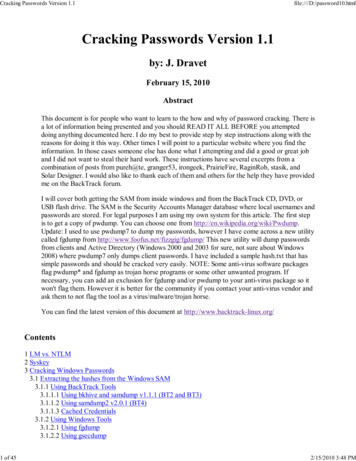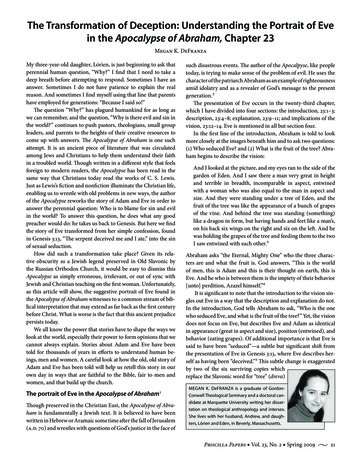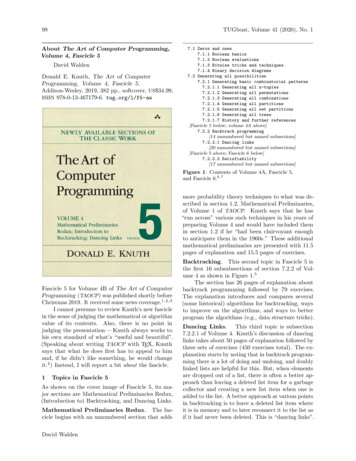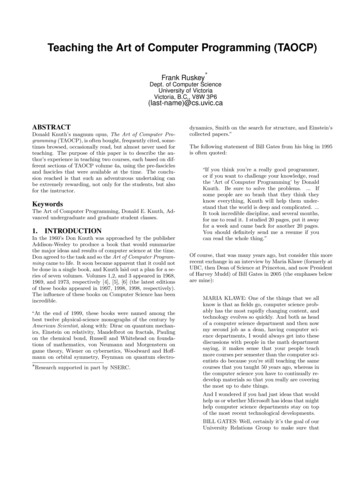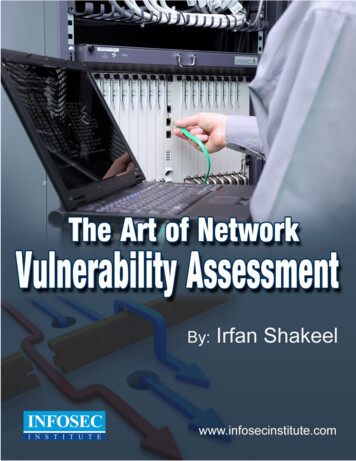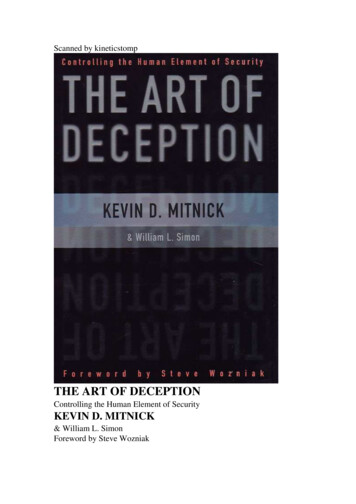
Transcription
Scanned by kineticstompTHE ART OF DECEPTIONControlling the Human Element of SecurityKEVIN D. MITNICK& William L. SimonForeword by Steve Wozniak
For Reba Vartanian, Shelly Jaffe, Chickie Leventhal, and MitchellMitnick, and for the late Alan Mitnick, Adam Mitnick,and Jack BielloFor Arynne, Victoria, and David, Sheldon,Vincent, and Elena.Social EngineeringSocial Engineering uses influence and persuasion to deceive peopleby convincing them that the social engineer is someone he is not,or by manipulation. As a result, the social engineer is able to takeadvantage of people to obtain information with or without the use rt 1 Behind the ScenesChapter 1 Security's Weakest LinkPart 2 The Art of the AttackerChapter 2 When Innocuous Information Isn'tChapter 3 The Direct Attack: Just Asking for itChapter 4 Building TrustChapter 5 "Let Me Help You"Chapter 6 "Can You Help Me?"Chapter 7 Phony Sites and Dangerous AttachmentsChapter 8 Using Sympathy, Guilt and IntimidationChapter 9 The Reverse StingPart 3 Intruder AlertChapter 10 Entering the PremisesChapter 11 Combining Technology and Social EngineeringChapter 12 Attacks on the Entry-Level EmployeeChapter 13 Clever ConsChapter 14 Industrial Espionage
Part 4 Raising the BarChapter 15 Information Security Awareness and TrainingChapter 16 Recommended Corporate Information Security PoliciesSecurity at a GlanceSourcesAcknowledgmentsForewordWe humans are born with an inner drive to explore the natureof our surroundings. As young men, both Kevin Mitnick andI were intensely curious about the world and eager to proveourselves. We were rewarded often in our attempts to learn new things,solve puzzles, and win at games. But at the same time, the world aroundus taught us rules of behavior that constrained our inner urge toward freeexploration. For our boldest scientists and technological entrepreneurs, aswell as for people like Kevin Mitnick, following this inner urge offers thegreatest thrills, letting us accomplish things that others believe cannot bedone.Kevin Mitnick is one of the finest people I know. Ask him, and he willsay forthrightly that what he used to do - social engineering - involesconning people. But Kevin is no longer a social engineer. And even whenhe was, his motive never was to enrich himself or damage others. That'snot to say that there aren't dangerous and destructive criminals out therewho use social engineering to cause real harm. In fact, that's exactly whyKevin wrote this book - to warn you about them.The Art of Deception shows how vulnerable we all are - government,business, and each of us personally - to the intrusions of the socialengineer. In this security-conscious era, we spend huge sums ontechnologyto protect our computer networks and data. This book points out how easyit is to trick insiders and circumvent all this technological protection.Whether you work in business or government, this book provides apowerful road map to help you understand how social engineers work andwhat you can do to foil them. Using fictionalized stories that are both
entertaining and eye-opening, Kevin and co-author Bill Simon bring tolifethe techniques of the social engineering underworld. After each story,they offer practical guidelines to help you guard against the breaches andthreats they're described.Technological security leaves major gaps that people like Kevin can helpus close. Read this book and you may finally realize that we all need toturn to the Mitnick's among us for guidance.-Steve Wozniak
PREFACESome hackers destroy people's files or entire hard drives; they're calledcrackers or vandals. Some novice hackers don't bother learning thetechnology, but simply download hacker tools to break into computersystems; they're called script kiddies. More experienced hackers withprogramming skills develop hacker programs and post them to the Weband to bulletin board systems. And then there are individuals who have nointerest in the technology, but use the computer merely as a tool to aidthem in stealing money, goods, or services.Despite the media-created myth of Kevin Mitnick, I am not a malicioushacker.But I'm getting ahead of myself.STARTING OUTMy path was probably set early in life. I was a happy-go-lucky kid, butbored. After my father split when I was three, my mother worked as awaitress to support us. To see me then - an only child being raised by amother who put in long, harried days on a sometimes-erratic schedule would have been to see a youngster on his own almost all his wakinghours. I was my own babysitter.Growing up in a San Fernando Valley community gave me the whole ofLos Angeles to explore, and by the age of twelve I had discovered a wayto travel free throughout the whole greater L.A. area. I realized one daywhile riding the bus that the security of the bus transfer I had purchasedrelied on the unusual pattern of the paper-punch, that the drivers used tomark day; time, and route on the transfer slips. A friendly driver,answering my carefully planted question, told me where to buy thatspecial type of punch.The transfers are meant to let you change buses and continue a journey toyour destination, but I worked out how to use them to travel anywhere Iwanted to go for free. Obtaining blank transfers was a walk in the park.
The trash bins at the bus terminals were always filled with only-partlyused books of transfers that the drivers tossed away at the end of theshifts. With a pad of blanks and the punch, I could mark my own transfersand travel anywhere that L.A. buses went. Before long, I had all butmemorized the bus schedules of the entire system. (This was an earlyexample of my surprising memory for certain types of information; I canstill, today, remember phone numbers, passwords, and other seeminglytrivial details as far back as my childhood.)Another personal interest that surfaced at an early age was my fascinationwith performing magic. Once I learned how a new trick worked, wouldpractice, practice, and practice some more until I mastered it. To anextent, it was through magic that I discovered the enjoyment in gainingsecret knowledge.From Phone Phreak to HackerMy first encounter with what I would eventually learn to call socialengineering came about during my high school years when I met anotherstudent who was caught up in a hobby called phone phreakin. Phonephreaking is a type of hacking that allows you to explore the telephonenetwork by exploiting the phone systems and phone company employees.He showed me neat tricks he could do with a telephone, like obtaining anyinformation the phone company had on any customer, and using a secrettest number to make long-distance calls for free. (Actually it was free onlyto us. I found out much later that it wasn't a secret test number at all. Thecalls were, in fact, being billed to some poor company's MCI account.)That was my introduction to social engineering-my kindergarten, so tospeak. My friend and another phone phreaker I met shortly thereafter letme listen in as they each made pretext calls to the phone company. I heardthe things they said that made them sound believable; I learned aboutdifferent phone company offices, lingo, and procedures. But that"training" didn't last long; it didn't have to. Soon I was doing it all on myown, learning as I went, doing it even better than my first teachers.The course my life would follow for the next fifteen years had been set. Inhigh school, one of my all-time favorite pranks was gaining unauthorizedaccess to the telephone switch and changing the class of service of afellow phone phreak. When he'd attempt to make a call from home, he'dget a message telling him to deposit a dime because the telephone
company switch had received input that indicated he was calling from apay phone.
I became absorbed in everything about telephones, not only theelectronics, switches, and computers, but also the corporate organization,the procedures, and the terminology. After a while, I probably knew moreabout the phone system than any single employee. And I had developedmy social engineering skills to the point that, at seventeen years old, I wasable to talk most telco employees into almost anything, whether I wasspeaking with them in person or by telephone.My much-publicized hacking career actually started when I was in highschool. While I cannot describe the detail here, suffice it to say that one ofthe driving forces in my early hacks was to be accepted by the guys in thehacker group.Back then we used the term hacker to mean a person who spent a greatdeal of time tinkering with hardware and software, either to develop moreefficient programs or to bypass unnecessary steps and get the job donemore quickly. The term has now become a pejorative, carrying themeaning of "malicious criminal." In these pages I use the term the way Ihave always used it - in its earlier, more benign sense.After high school I studied computers at the Computer Learning Center inLos Angeles. Within a few months, the school's computer managerrealized I had found vulnerability in the operating system and gained fulladministrative privileges on their IBM minicomputer. The best computerexperts on their teaching staff couldn't figure out how I had done this. Inwhat may have been one of the earliest examples of "hire the hacker," Iwas given an offer I couldn't refuse: Do an honors project to enhance theschool's computer security, or face suspension for hacking the system. Ofcourse, I chose to do the honors project, and ended up graduating cumlaude with honors.Becoming a Social EngineerSome people get out of bed each morning dreading their daily workroutine at the proverbial salt mines. I've been lucky enough to enjoy mywork. n particular, you can't imagine the challenge, reward, and pleasure Ihad the time I spent as a private investigator. I was honing my talents inthe performance art called social engineering (getting people to do thingsthey wouldn't ordinarily do for a stranger) and being paid for it.
For me it wasn't difficult becoming proficient in social engineering. Myfather's side of the family had been in the sales field for generations, sothe art of influence and persuasion might have been an inherited trait.When you combine that trait with an inclination for deceiving people, youhave the profile of a typical social engineer.
You might say there are two specialties within the job classification ofcon artist. Somebody who swindles and cheats people out of their moneybelongs to one sub-specialty, the grifter. Somebody who uses deception,influence, and persuasion against businesses, usually targeting theirinformation, belongs to the other sub-specialty, the social engineer. Fromthe time of my bus-transfer trick, when I was too young to know therewas anything wrong with what I was doing, I had begun to recognize atalent for finding out the secrets I wasn't supposed to have. I built on thattalent by using deception, knowing the lingo, and developing a wellhoned skill of manipulation.One way I worked on developing the skills of my craft, if I may call it acraft, was to pick out some piece of information I didn't really care aboutand see if I could talk somebody on the other end of the phone intoproviding it, just to improve my skills. In the same way I used to practicemy magic tricks, I practiced pretexting. Through these rehearsals, I soonfound that I could acquire virtually any information I targeted.As I described in Congressional testimony before Senators Lieberman andThompson years later:I have gained unauthorized access to computer systems at some of thelargest corporations on the planet, and have successfully penetrated someof the most resilient computer systems ever developed. I have used bothtechnical and non-technical means to obtain the source code to variousoperating systems and telecommunications devices to study theirvulnerabilities and their inner workings.All of this activity was really to satisfy my own curiosity; to see what Icould do; and find out secret information about operating systems, cellphones, and anything else that stirred my curiosity.FINAL THOUGHTSI've acknowledged since my arrest that the actions I took were illegal, andthat I committed invasions of privacy.My misdeeds were motivated by curiosity. I wanted to know as much as Icould about how phone networks worked and the ins-and-outs ofcomputer security. I went from being a kid who loved to perform magictricks to becoming the world's most notorious hacker, feared by
corporations and the government. As I reflect back on my life for the last30 years, I admit I made some extremely poor decisions, driven by mycuriosity, the desire to learn about technology, and the need for a goodintellectual challenge.
I'm a changed person now. I'm turning my talents and the extensiveknowledge I've gathered about information security and socialengineering tactics to helping government, businesses, and individualsprevent, detect, and respond to information-security threats.This book is one more way that I can use my experience to help othersavoid the efforts of the malicious information thieves of the world. I thinkyou will find the stories enjoyable, eye-opening, and educational.
IntroductionThis book contains a wealth of information about information security andsocial engineering. To help you find your way, here's a quick look at howthis book is organized:In Part 1 I'll reveal security's weakest link and show you why you andyour company are at risk from social engineering attacks.In Part 2 you'll see how social engineers toy with your trust, your desire tobe helpful, your sympathy, and your human gullibility to get what theywant. Fictional stories of typical attacks will demonstrate that socialengineers can wear many hats and many faces. If you think you've neverencountered one, you're probably wrong. Will you recognize a scenarioyou've experienced in these stories and wonder if you had a brush withsocial engineering? You very well might. But once you've read Chapters 2through 9, you'll know how to get the upper hand when the next socialengineer comes calling.Part 3 is the part of the book where you see how the social engineer upsthe ante, in made-up stories that show how he can step onto yourcorporate premises, steal the kind of secret that can make or break yourcompany, and thwart your hi-tech security measures. The scenarios in thissection will make you aware of threats that range from simple employeerevenge to cyber terrorism. If you value the information that keeps yourbusiness running and the privacy of your data, you'll want to readChapters 10 through 14 from beginning to end.It's important to note that unless otherwise stated, the anecdotes in thisbook are purely fictional.In Part 4 I talk the corporate talk about how to prevent successful socialengineering attacks on your organization. Chapter 15 provides a blueprintfor a successful security-training program. And Chapter 16 might justsave your neck - it's a complete security policy you can customize foryour organization and implement right away to keep your company andinformation safe.
Finally, I've provided a Security at a Glance section, which includeschecklists, tables, and charts that summarize key information you can useto help your employees foil a social engineering attack on the job. Thesetools also provide valuable information you can use in devising your ownsecurity-training program.Throughout the book you'll also find several useful elements: Lingo boxesprovide definitions of social engineering and computer hackerterminology; Mitnick Messages offer brief words of wisdom to helpstrengthen your security strategy; and notes and sidebars give interestingbackground or additional information.
Part 1Behind The Scenes
Chapter 1Security's Weakest LinkA company may have purchased the best security technologies that moneycan buy, trained their people so well that they lock up all their secretsbefore going home at night, and hired building guards from the bestsecurity firm in the business.That company is still totally Vulnerable.Individuals may follow every best-security practice recommended by theexperts, slavishly install every recommended security product, and bethoroughly vigilant about proper system configuration and applyingsecurity patches.Those individuals are still completely vulnerable.THE HUMAN FACTORTestifying before Congress not long ago, I explained that I could often getpasswords and other pieces of sensitive information from companies bypretending to be someone else and just asking for it.It's natural to yearn for a feeling of absolute safety, leading many peopleto settle for a false sense of security. Consider the responsible and lovinghomeowner who has a Medico, a tumbler lock known as being pickproof,installed in his front door to protect his wife, his children, and his home.He's now comfortable that he has made his family much safer againstintruders. But what about the intruder-who breaks a window, or cracks thecode to the garage door opener? How about installing a robust securitysystem? Better, but still no guarantee. Expensive locks or no, thehomeowner remains vulnerable.Why? Because the human factor is truly security's weakest link.
Security is too often merely an illusion, an illusion sometimes made evenworse when gullibility, naivete, or ignorance come into play. The world'smost respected scientist of the twentieth century, Albert Einstein, isquoted as saying, "Only two things are infinite, the universe and humanstupidity, and I'm not sure about the former." In the end, socialengineering attacks can succeed when people are stupid or, morecommonly, simply ignorant about good security practices. With the sameattitude as our security-conscious homeowner, many informationtechnology (IT) professionals hold to the misconception that they've madetheir companies largely immune to attack because they've deployedstandard security products - firewalls, intrusion detection systems, orstronger authentication devices such as time-based tokens or biometricsmart cards. Anyone who thinks that security products alone offer truesecurity is settling for. the illusion of security. It's a case of living in aworld of fantasy: They will inevitably, later if not sooner, suffer a securityincident.As noted security consultant Bruce Schneier puts it, "Security is not aproduct, it's a process." Moreover, security is not a technology problem it's a people and management problem.As developers invent continually better security technologies, making itincreasingly difficult to exploit technical vulnerabilities, attackers willturn more and more to exploiting the human element. Cracking the humanfirewall is often easy, requires no investment beyond the cost of a phonecall, and involves minimal risk.A CLASSIC CASE OF DECEPTIONWhat's the greatest threat to the security of your business assets? That'seasy: the social engineer--an unscrupulous magician who has youwatching his left hand while with his right he steals your secrets. Thischaracter is often so friendly, glib, and obliging that you're grateful forhaving encountered him.Take a look at an example of social engineering. Not many people todaystill remember the young man named Stanley Mark Rifkin and his littleadventure with the now defunct Security Pacific National Bank in LosAngeles. Accounts of his escapade vary, and Rifkin (like me) has nevertold his own story, so the following is based on published reports.
Code BreakingOne day in 1978, Rifkin moseyed over to Security Pacific's authorizedpersonnel-only wire-transfer room, where the staff sent and receivedtransfers totaling several billion dollars every day.
He was working for a company under contract to develop a backupsystem for the wire room's data in case their main computer ever wentdown. That role gave him access to the transfer procedures, including howbank officials arranged for a transfer to be sent. He had learned that bankofficers who were authorized to order wire transfers would be given aclosely guarded daily code each morning to use when calling the wireroom.In the wire room the clerks saved themselves the trouble of trying tomemorize each day's code: They wrote down the code on a slip of paperand posted it where they could see it easily. This particular November dayRifkin had a specific reason for his visit. He wanted to get a glance at thatpaper.Arriving in the wire room, he took some notes on operating procedures,supposedly to make sure the backup system would mesh properly with theregular systems. Meanwhile, he surreptitiously read the security codefrom the posted slip of paper, and memorized it. A few minutes later hewalked out. As he said afterward, he felt as if he had just won the lottery.There's This Swiss Bank Account.Leaving the room at about 3 o'clock in the afternoon, he headed straightfor the pay phone in the building's marble lobby, where he deposited acoin and dialed into the wire-transfer room. He then changed hats,transforming himself from Stanley Rifkin, bank consultant, into MikeHansen, a member of the bank's International Department.According to one source, the conversation went something like this:"Hi, this is Mike Hansen in International," he said to the young womanwho answered the phone.She asked for the office number. That was standard procedure, and he wasprepared: “286” he said.The girl then asked, "Okay, what's the code?"Rifkin has said that his adrenaline-powered heartbeat "picked up its pace"at this point. He responded smoothly, "4789." Then he went on to giveinstructions for wiring "Ten million, two-hundred thousand dollarsexactly" to the Irving Trust Company in New York, for credit of the
Wozchod Handels Bank of Zurich, Switzerland, where he had alreadyestablished an account.The girl then said, "Okay, I got that. And now I need the interofficesettlement number."Rifkin broke out in a sweat; this was a question he hadn't anticipated,something that had slipped through the cracks in his research. But he
managed to stay in character, acted as if everything was fine, and on thespot answered without missing a beat, "Let me check; I'll call you rightback." He changed hats once again to call another department at the bank,this time claiming to be an employee in the wire-transfer room. Heobtained the settlement number and called the girl back.She took the number and said, "Thanks." (Under the circumstances, herthanking him has to be considered highly ironic.)Achieving ClosureA few days later Rifkin flew to Switzerland, picked up his cash, andhanded over 8 million to a Russian agency for a pile of diamonds. Heflew back, passing through U.S. Customs with the stones hidden in amoney belt. He had pulled off the biggest bank heist in history--and doneit without using a gun, even without a computer. Oddly, his capereventually made it into the pages of the Guinness Book of World Recordsin the category of "biggest computer fraud."Stanley Rifkin had used the art of deception--the skills and techniques thatare today called social engineering. Thorough planning and a good gift ofgab is all it really took.And that's what this book is about--the techniques of social engineering(at which yours truly is proficient) and how to defend against their beingused at your company.THE NATURE OF THE THREATThe Rifkin story makes perfectly clear how misleading our sense ofsecurity can be. Incidents like this - okay, maybe not 10 million heists,but harmful incidents nonetheless - are happening every day. You may belosing money right now, or somebody may be stealing new product plans,and you don't even know it. If it hasn't already happened to yourcompany, it's not a question of if it will happen, but when.A Growing ConcernThe Computer Security Institute, in its 2001 survey of computer crime,reported that 85 percent of responding organizations had detectedcomputer security breaches in the preceding twelve months. That's anastounding number: Only fifteen out of every hundred organizationsresponding were able to say that they had not had a security breach during
the year. Equally astounding was the number of organizations thatreported that they had experienced financial losses due to computer
breaches: 64 percent. Well over half the organizations had sufferedfinancially. In a single year.My own experiences lead me to believe that the numbers in reports likethis are somewhat inflated. I'm suspicious of the agenda of the peopleconducting the survey. But that's not to say that the damage isn'textensive; it is. Those who fail to plan for a security incident are planningfor failure.Commercial security products deployed in most companies are mainlyaimed at providing protection against the amateur computer intruder, likethe youngsters known as script kiddies. In fact, these wannabe hackerswith downloaded software are mostly just a nuisance. The greater losses,the real threats, come from sophisticated attackers with well-definedtargets who are motivated by financial gain. These people focus on onetarget at a time rather than, like the amateurs, trying to infiltrate as manysystems as possible. While amateur computer intruders simply go forquantity, the professionals target information of quality and value.Technologies like authentication devices (for proving identity), accesscontrol (for managing access to files and system resources), and intrusiondetection systems (the electronic equivalent of burglar alarms) arenecessary to a corporate security program. Yet it's typical today for acompany to spend more money on coffee than on deployingcountermeasures to protect the organization against security attacks.Just as the criminal mind cannot resist temptation, the hacker mind isdriven to find ways around powerful security technology safeguards. Andin many cases, they do that by targeting the people who use thetechnology.Deceptive PracticesThere's a popular saying that a secure computer is one that's turned off.Clever, but false: The pretexter simply talks someone into going into theoffice and turning that computer on. An adversary who wants yourinformation can obtain it, usually in any one of several different ways. It'sjust a matter of time, patience, personality, and persistence. That's wherethe art of deception comes in.
To defeat security measures, an attacker, intruder, or social engineer mustfind a way to deceive a trusted user into revealing information, or trick anunsuspecting mark into providing him with access. When trustedemployees are deceived, influenced, or manipulated into revealingsensitive information, or performing actions that create a security hole forthe attacker to slip through, no technology in the world can protect abusiness. Just as cryptanalysts are sometimes able to reveal the plain textof a coded message by finding a weakness that lets them bypass theencryption
technology, social engineers use deception practiced on your employeesto bypass security technology.ABUSE OF TRUSTIn most cases, successful social engineers have strong people skills.They're charming, polite, and easy to like--social traits needed forestablishing rapid rapport and trust. An experienced social engineer isable to gain access to virtually any targeted information by using thestrategies and tactics of his craft.Savvy technologists have painstakingly developed information-securitysolutions to minimize the risks connected with the use of computers, yetleft unaddressed the most significant vulnerability, the human factor.Despite our intellect, we humans - you, me, and everyone else - remainthe most severe threat to each other's security.Our National CharacterWe're not mindful of the threat, especially in the Western world. In theUnited States most of all, we're not trained to be suspicious of each other.We are taught to "love thy neighbor" and have trust and faith in eachother. Consider how difficult it is for neighborhood watch organizationsto get people to lock their homes and cars. This sort of vulnerability isobvious, and yet it seems to be ignored by many who prefer to live in adream world - until they get burned.We know that all people are not kind and honest, but too often we live asif they were. This lovely innocence has been the fabric of the lives ofAmericans and it's painful to give it up. As a nation we have built into ourconcept of freedom that the best places to live are those where locks andkeys are the least necessary.Most people go on the assumption that they will not be deceived byothers, based upon a belief that the probability of being deceived is verylow; the attacker, understanding this common belief, makes his requestsound so reasonable that it raises no suspicion, all the while exploiting thevictim's trust.Organizational Innocence
That innocence that is part of our national character was evident backwhen computers were first being connected remotely. Recall that theARPANet (the Defense Department's Advanced Research ProjectsAgency
Network), the predecessor of the Internet, was designed as a way ofsharing research information between government, research, andeducational institutions. The goal was information freedom, as well astechnological advancement. Many educational institutions therefore set upearly computer systems with little or no security. One noted softwarelibertarian, Richard Stallman, even refused to protect his account with apassword.But with the Internet being used for electronic commerce, the dangers ofweak security in our wired world have changed dramatically. Deployingmore technology is not going to solve the human security problem.Just look at our airports today. Security has become paramount, yet we'realarmed by media reports of travelers who have been able to circumventsecurity and carry potential weapons past checkpoints. How is thispossible during a time when our airports are on such a state of alert? Arethe metal
The Art of Deception shows how vulnerable we all are - government, business, and each of us personally - to the intrusions of the social engineer. In this security-conscious era, we spend huge sums on technology to protect our
